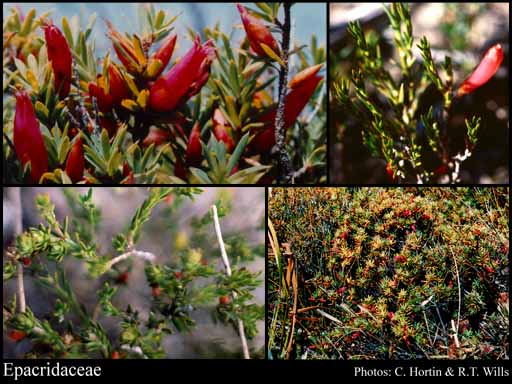This name is not current. Find out more information on related names.
- Reference
- Prodr.Fl.Nov.Holland. 535 (1810)
- Name Status
- Not Current

Scientific Description
Common name. Heath Family.
Habit and leaf form. Small trees, or shrubs (often ‘ericoid’); evergreen; leptocaul, or pachycaul. Helophytic to xerophytic (mostly on acid substrates). Leaves minute to medium-sized; alternate; spiral, or four-ranked; ‘herbaceous’, or leathery; imbricate, or not imbricate; petiolate to sessile; sheathing (Cosmelia, Andersonia, Sprengelia, Dracophyllum, Richea Sphenotoma — associated with a very peculiar mode of leaf abscission, resulting in sloughing away of the outer parts of the stem), or non-sheathing. Leaf sheaths when present, with free margins. Leaves simple. Leaf blades entire; flat, or rolled; one-veined, or palmately veined (commonly), or parallel-veined (genuinely so in Richeoideae, but only ostensibly so in Cosmelieae where the parallel veins in the lamina originate palmately from a single leaf trace); cross-venulate, or without cross-venules. Leaves without stipules. Leaf blade margins flat, or revolute. Stem anatomy. Nodes unilacunar (mostly), or tri-lacunar to multilacunar (Dracophyllum, Richea). Secondary thickening developing from a conventional cambial ring.
Reproductive type, pollination. Fertile flowers hermaphrodite. Unisexual flowers absent. Plants hermaphrodite (nearly always). Entomophilous, or ornithophilous. Pollination mechanism conspicuously specialized (via passive presentation involving corolla hairs, in Acrotriche serrulata), or unspecialized.
Inflorescence and flower features. Flowers solitary, or aggregated in ‘inflorescences’. Inflorescences terminal, or axillary. Flowers bracteate; bracteolate; small to medium-sized, or minute (rarely); fragrant, or odourless; regular; mostly (4–)5 merous; cyclic; tetracyclic. Free hypanthium absent. Hypogynous disk present (usually), or absent (e.g. Sprengelia); intrastaminal; of separate members, or annular. Perianth with distinct calyx and corolla; 8 (Oligarrhena), or 10; 2 -whorled; isomerous. Calyx 4 (Oligarrhena only), or 5; 1 -whorled; polysepalous; imbricate; regular; persistent. Corolla 4 (Oligarrhena only), or 5; 1 -whorled; polypetalous, or gamopetalous; imbricate, or valvate (or induplicate-valvate in Needhamiella only), or contorted (Lysinema); regular; green, or white, or red, or pink, or purple, or blue; persistent, or deciduous. Androecium (4–)5, or 2 (Oligarrhena). Androecial members free of the perianth (Andersonia, Sprengelia, Lysinema, Prionotes, Lebetanthus), or adnate (to the corolla); all equal; free of one another; 1 -whorled. Androecium exclusively of fertile stamens. Stamens (4–)5 (usually), or 2 (Oligarrhena); reduced in number relative to the adjacent perianth to isomerous with the perianth; oppositisepalous (hypogynous or epipetalous); all alternating with the corolla members; laminar, or filantherous. Anthers basifixed, or adnate; becoming inverted during development, their morphological bases ostensibly apical in the mature stamens; non-versatile; dehiscing via longitudinal slits (usually by a single median slit, rarely by two — e.g. Conostephium); finally introrse (inverting during development, cf. Ericaceae); unilocular (usually), or bilocular; bisporangiate; unappendaged (but their apices sometimes sterile). Pollen shed in aggregates (usually), or shed as single grains; without viscin strands; in diads, or in triplets, or in tetrads. Gynoecium (2–)5(–10) carpelled (consistently 2 only in Oligarrhena and Needhamiella). The pistil (1–)5(–10) celled. Gynoecium syncarpous; eu-syncarpous; superior. Ovary unilocular, or plurilocular; (1–)5(–10) locular. Gynoecium stylate. Styles 1; attenuate from the ovary (Cosmelieae, Epacrideae, Richeoideae), or from a depression at the top of the ovary (Styphelieae, Oligarrhena, Needhamiella); apical. Stigmas 1; truncate, or clavate, or capitate. Placentation axile. Ovules 1–50 per locule (i.e. to ‘many’); pendulous (usually), or ascending (Archeria); non-arillate; anatropous.
Fruit and seed features. Fruit fleshy, or non-fleshy; dehiscent (Cosmelieae, Epacrideae, Richeoideae), or indehiscent (Styphelieae, Oligarrhena, Needhamiella); a capsule (when dehiscent), or a drupe. The drupes with separable pyrenes, or with one stone. Capsules loculicidal. Seeds endospermic. Endosperm oily. Seeds wingless. Embryo well differentiated. Cotyledons 2. Embryo straight. Seedling. Germination phanerocotylar.
Physiology, biochemistry. Aluminium accumulation not found. Photosynthetic pathway: C3.
Geography, cytology, number of species. World distribution: Indonesia to New Zealand, Hawaii to southern South America, but mainly Australia. X = 4–14. 400 species.